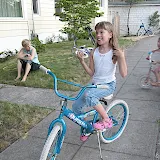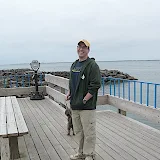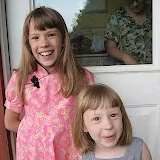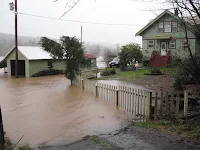 Built in 1911, the Grays River Covered Bridge is the last of its kind serving a public road in the state of Washington.
Built in 1911, the Grays River Covered Bridge is the last of its kind serving a public road in the state of Washington.
Eight years ago the local WSU Extension office and 4-H organizers had a great idea. A fall community harvest dinner featuring donated salmon and local veggies grown in the valley - served by by 4H kids inside the bridge on a beautiful October night.
While tourists may occasionally venture off highway 4 to see the bridge, for us locals it remains an important way to cross the river to reach the other side of the valley. Just as it has for the past 100 years, this bridge brings us together.
Hans Ahlberg owned both sides of the river back in 1905. He and his neighbors saw the need to get crops and cattle to pasture and to market. There was a foot bridge at the time but the only way to get a cart across the river was by ford the waters at low tide. Ahlberg and his neighbors convinced the county to pay for it, but many of the locals invested sweat equity in the project to offset their taxes.
It became a covered bridge in 1908 to protect the wood from the ravages of wind and rain. A century later, the bridge was weather beaten and at risk of being torn down. The people of the valley, however, worked to secure funding for a major restoration.
Rarely are bridges manifested by the hands of a single individual. Bridges are creations of community -- monuments to cooperation, knitting peoples across geographic barriers into tighter daily relationships.
Amy and I were married at this bridge 24 years ago. She and her bridesmaids arriving by horse drawn wagon through the covered bridge to Ahlberg park. On hot summer days children cool off on the smooth stone beach and swim clear waters the flow below.
It is one of two bridges that are constants in our lives.
The Astoria-Megler bridge just celebrated its 50th birthday this year.
The Astoria bridge shows how these works of infrastructure don’t happen overnight. It was almost 40 years between the first proposal span the Columbia at Astoria, to the dedication ceremony in 1966. It was not an easy task. Washington and Oregon had very different ideas about the necessity of the bridge and how it should be paid for. Washington opposed having a toll on the bridge and wanted Oregon to pay the lion’s share of the cost.
When it finally came together, it did so through bare-knuckle negotiation and compromise. Compromise has become a dirty word of late -- as if it is tainted with weakness. Yet compromise is the loamy soil that yields value and progress in a democracy.
When the link between Washington and Oregon was finally established, a reported 30,000 people came down for the dedication of the so-called “bridge to nowhere.” Thousands more paid the toll to cross it each year, the numbers growing each decade.
The bridge was paid off early and the toll taken down. Amy and I remember one Christmas eve on our way to midnight mass in Astoria in 1993, the toll collectors waving us through.
These creations elegantly change the landscape of our possibilities. They open to us easy access to neighbors and friends, jobs and education, culture and life bound no longer by the natural obstruction of indignant rivers.
 |
| Stone Walls in Ireland. Credit Amusing Planet |
The lots bound by these stones were small and tragic, without gates.
If bridges are built of compromise and community, walls are built up of grievances.
Like our grievances, walls can last years -- indeed well outlast their builders -- yet be held together by nothing. Gateless hard little grids that let nothing out, or nothing in.
Bridges are different.
This marks 25 years since I first set foot into this valley - a college boy visiting his true love’s parent’s home for the first time. In that quarter century I have become a fixed point in a living, breathing community of characters. I am still best known as Amy’s husband, no doubt, but I have unintentionally made my mark here and there upon the landscape.
Being part of a community is not always easy for me. I am in no ways shy, but I have an inner hermit that would much rather sit alone by the fire. Most at ease when I am hiding behind a keyboard or camera, I avoid parties and crowds. I am a poor friend and a distant brother. Never had a clique of friends, never joined a softball team or bowling league.
When I do join, I worry over the poverty of my contributions.
Yet, I have lived here longer than any other place in my lifetime, and I know I am a part of my beloved rain-soaked forest.
The connections we form with other people are the cement that holds our lives together. We are social animals, we thrive with ties to other people. Research has shown that the number of people we interact with on a daily basis is a predictor of our sense of belonging and well being.
“Studies indicate that “social capital” is one of the biggest predictors for health, happiness, and longevity,” explains Cecile Andrews, author of Living Room Revolution: A Handbook for Conversation, Community, and the Common Good. “The problem: we often do not recognize the importance of social connection. Our culture values hard work, success, and wealth, so it’s no surprise some of us do not set aside enough time for social ties when we think security lies in material things rather than other people.”
Community is what people do to help one another.
In our little valley there is a food bank, community education, a wildly successful locally-organized blood drive. There are adoptions, weddings, births and funerals. Houses hold the names of their previous occupants long after they are gone.
No one is perfect, every face has a flaw. Like a family, however, like your brothers and sisters you learn to live together. As new people move in, they either adapt to the ebb and flow of the river and the rain, or they find a reason not to stay.
We are, after all, a long way from anywhere and the winter is dark and gray.
So it was that we found ourselves inside a covered bridge on a rain-soaked October night. Hundreds of us, feasting on salmon and ham, potatoes and squash, under amber lights and violin, tin roof and wood walls against the early-autumn storm outside. The rain held off just long enough to get the salmon barbequed, to get everyone seated at the long tables.
So it was that we were warm and dry, shoulder to shoulder while the wind and rain battered aged tin and cedar, while mud-clouded river flowed below our feet.
Here we were together the people of the Grays River Valley.
Here we were together, a community, a bridge.







